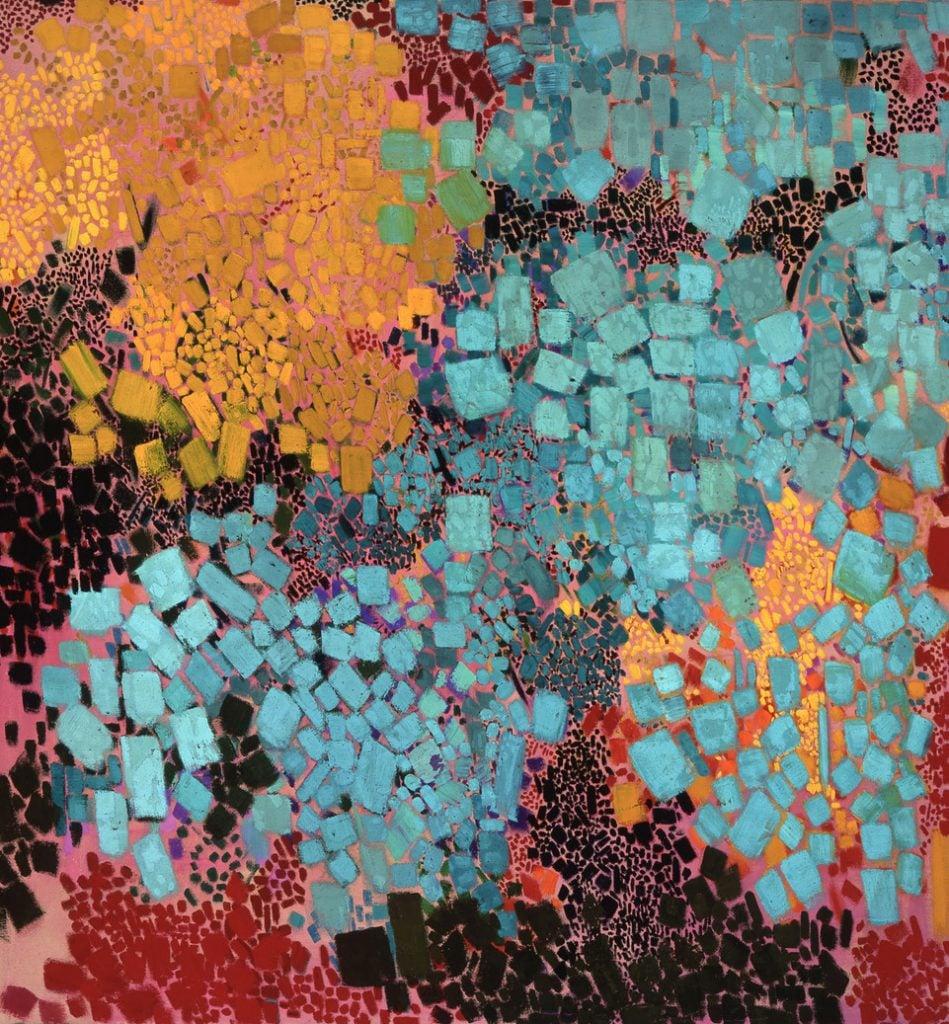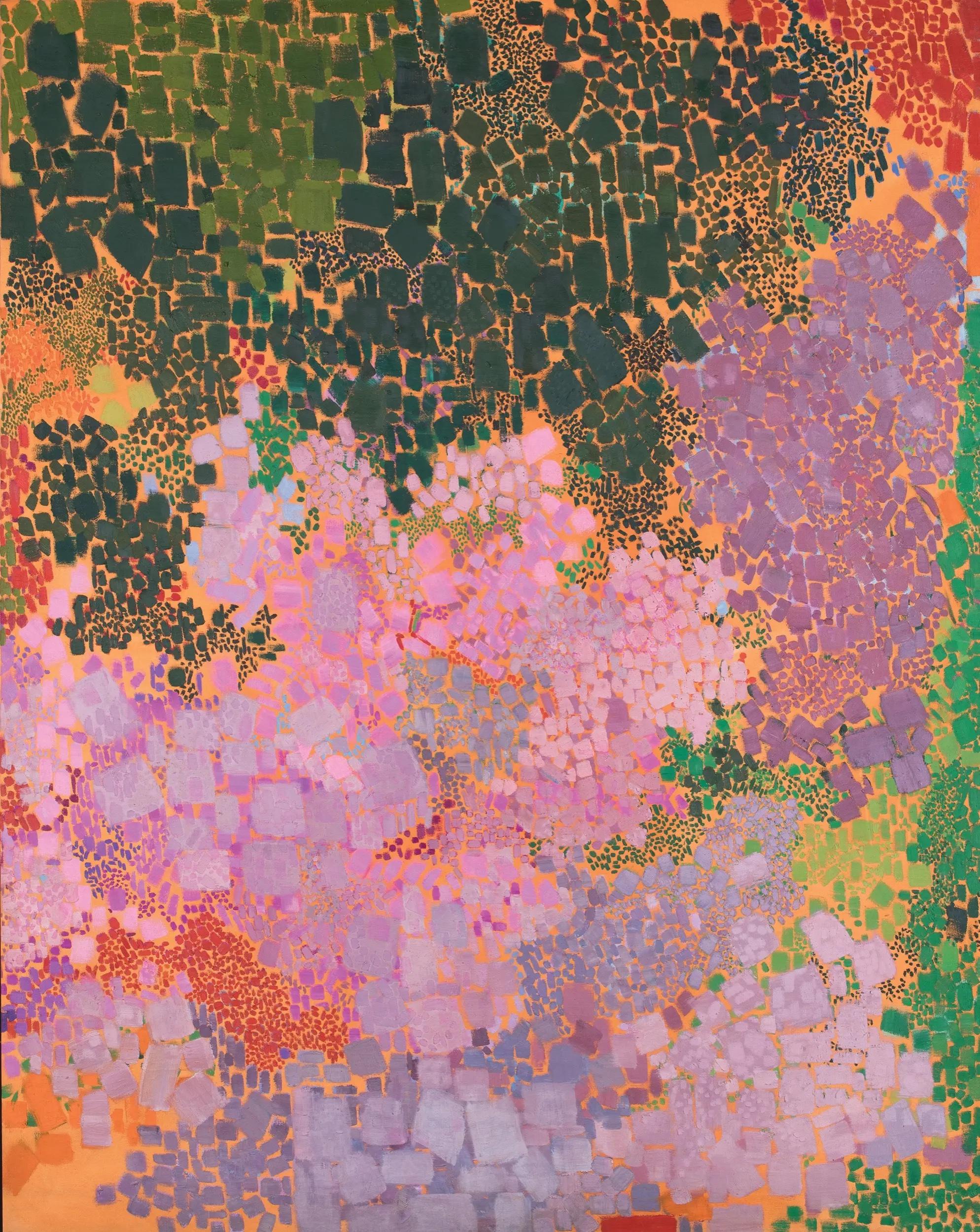New year, new big art thread!
-
Paintings by American artist Stephen Towns, 2020s, whose practice elevates Black American figures often left out of mainstream histories, such as miners, service workers, and prisoners.
-
Works by Japanese artist Kosen Ohtsubo, 1970s-90s, whose practice pushes the limits of ikebana (the Japanese art of flower arranging).
Paintings by American artist Pat Lipsky, 1970s, who was associated with the Color Field and Lyrical Abstraction movements.
-
Paintings by American artist Pat Lipsky, 1970s, who was associated with the Color Field and Lyrical Abstraction movements.
Textile pieces by Canadian artist Zadie Xa, 2010s-20s, whose work "is informed by her experiences within the Korean diaspora, traditional folk tales, and mythology as well as the environmental and cultural context of the Pacific Northwest."
-
Textile pieces by Canadian artist Zadie Xa, 2010s-20s, whose work "is informed by her experiences within the Korean diaspora, traditional folk tales, and mythology as well as the environmental and cultural context of the Pacific Northwest."
Paintings by Ethiopian-born, Milan-based artist Jem Perucchini, 2020s, whose portraits center Black figures in Renaissance-inspired compositions.
-
Paintings by Ethiopian-born, Milan-based artist Jem Perucchini, 2020s, whose portraits center Black figures in Renaissance-inspired compositions.
Works by American artist and occultist Marjorie Cameron Parsons (aka Cameron), 1950s-60s, who was introduced to Aleister Crowley's Thelemic religion through her husband, rocket scientist Jack Parsons. She was affiliated with the LA avant-garde, working w/ Curtis Harrington and Kenneth Anger.
-
Works by American artist and occultist Marjorie Cameron Parsons (aka Cameron), 1950s-60s, who was introduced to Aleister Crowley's Thelemic religion through her husband, rocket scientist Jack Parsons. She was affiliated with the LA avant-garde, working w/ Curtis Harrington and Kenneth Anger.
Paintings by English artist Clare Woods, 2020s, whose compositions are based on found and personal photographs.
-
Paintings by English artist Clare Woods, 2020s, whose compositions are based on found and personal photographs.
Sculpture by Helen Pashgian, 2000s-20s, who was a member of the Light and Space Movement in the 60s, known for her use of industrial and semi-translucent materials that capture light.
-
Sculpture by Helen Pashgian, 2000s-20s, who was a member of the Light and Space Movement in the 60s, known for her use of industrial and semi-translucent materials that capture light.
Collages by NYC-based Bahamian artist Tavares Strachen, 2020s, whose "The Encyclopedia of Invisibility" is a research-based project that combines art, science, history, and cultural critique while exploring invisibility, displacement, and loss.
-
Collages by NYC-based Bahamian artist Tavares Strachen, 2020s, whose "The Encyclopedia of Invisibility" is a research-based project that combines art, science, history, and cultural critique while exploring invisibility, displacement, and loss.
-
Works by German American photographer Uta Barth, 1990s, whose practice explores the ephemeral qualities of light and its destabilizing effect on vision.
#art #photography BigArtThread
-
Works by Moroccan artist Latifa Toujani, 1970s.
Paintings by American artist Kate Meissner, 2020s.
-
Paintings by American artist Kate Meissner, 2020s.
Sculpture by American artist Hugh Hayden, 2010s-20s, whose practice often incorporates salvaged wood into metaphors for the Black American experience, exploring how human interactions with the environment connect to class, race, and identity.
-
Sculpture by American artist Hugh Hayden, 2010s-20s, whose practice often incorporates salvaged wood into metaphors for the Black American experience, exploring how human interactions with the environment connect to class, race, and identity.
Works by German artist Rudolf Schlichter, 1920s, a member of the New Objectivity movement known for his portraits depicting urban life in Weimar Berlin. In the 30s he was denounced as "Degenerate" by the Nazis, and his studio was destroyed by Allied bombs in 1942.
-
Works by German artist Rudolf Schlichter, 1920s, a member of the New Objectivity movement known for his portraits depicting urban life in Weimar Berlin. In the 30s he was denounced as "Degenerate" by the Nazis, and his studio was destroyed by Allied bombs in 1942.
Works by Puerto Rican NYC (Nuyorican) artist Glendalys Medina, 2020s, who created these abstract works as exercises in gratitude, a practice they started in the early days of the pandemic.
-
Works by Puerto Rican NYC (Nuyorican) artist Glendalys Medina, 2020s, who created these abstract works as exercises in gratitude, a practice they started in the early days of the pandemic.
Paintings by American artist Eleanor Spiess-Ferris, 2000s-10s.
-
Paintings by American artist Eleanor Spiess-Ferris, 2000s-10s.
Photos by Slovak artist Jana Šantavá, 2020s, known for her surreal imagery often employing doubles, mirrors, and bold color palettes.
-
Photos by Slovak artist Jana Šantavá, 2020s, known for her surreal imagery often employing doubles, mirrors, and bold color palettes.
Sculpture by American artist Greer Lankton, 1980s-90s, whose distinctive dolls and installations reflected her own experiences as a trans woman and drug user, along with odes to icons like Candy Darling, Diana Vreeland, and Divine.
-
Sculpture by American artist Greer Lankton, 1980s-90s, whose distinctive dolls and installations reflected her own experiences as a trans woman and drug user, along with odes to icons like Candy Darling, Diana Vreeland, and Divine.
Abstract paintings by Walla Walla artist James Lavadour, 2000s-10s, who grew up on the Umatilla Indian Reservation and whose work is inspired by the Blue Mountains and landscapes of Western Oregon.
-
Abstract paintings by Walla Walla artist James Lavadour, 2000s-10s, who grew up on the Umatilla Indian Reservation and whose work is inspired by the Blue Mountains and landscapes of Western Oregon.
"Fiori Futuristi" (Futurist Flowers) sculpture by Italian artist Giacomo Balla, 1918-25 (reconstructed in 1968). Balla was a founding member of the Futurist movement, which celebrated industrialization, machinery, speed, and movement, often showing objects from multiple perspectives.
-
"Fiori Futuristi" (Futurist Flowers) sculpture by Italian artist Giacomo Balla, 1918-25 (reconstructed in 1968). Balla was a founding member of the Futurist movement, which celebrated industrialization, machinery, speed, and movement, often showing objects from multiple perspectives.
Paintings by Iranian artist Golnaz Afraz, 2020s.




